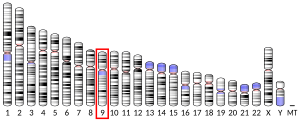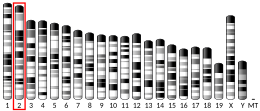TOR2A
Izgled
Torzin-2A je protein koji je kod ljudi kodiran genom TOR2A.[5][6]
Aminokiselinska sekvenca
[uredi | uredi izvor]Dužina polipeptidnog lanca je 321 aminokiselina, а molekulska težina 35.714 Da.[7]
| 10 | 20 | 30 | 40 | 50 | ||||
|---|---|---|---|---|---|---|---|---|
| MAAATRGCRP | WGSLLGLLGL | VSAAAAAWDL | ASLRCTLGAF | CECDFRPDLP | ||||
| GLECDLAQHL | AGQHLAKALV | VKALKAFVRD | PAPTKPLVLS | LHGWTGTGKS | ||||
| YVSSLLAHYL | FQGGLRSPRV | HHFSPVLHFP | HPSHIERYKK | DLKSWVQGNL | ||||
| TACGRSLFLF | DEMDKMPPGL | MEVLRPFLGS | SWVVYGTNYR | KAIFIFISNT | ||||
| GGKQINQVAL | EAWRSRRDRE | EILLQELEPV | ISRAVLDNPH | HGFSNSGIME | ||||
| ERLLDAVVPF | LPLQRHHVRH | CVLNELAQLG | LEPRDEVVQA | VLDSTTFFPE | ||||
| DEQLFSSNGC | KTVASRIAFF | L |
Reference
[uredi | uredi izvor]- ^ a b c GRCh38: Ensembl release 89: ENSG00000160404 - Ensembl, maj 2017
- ^ a b c GRCm38: Ensembl release 89: ENSMUSG00000009563 - Ensembl, maj 2017
- ^ "Human PubMed Reference:". National Center for Biotechnology Information, U.S. National Library of Medicine.
- ^ "Mouse PubMed Reference:". National Center for Biotechnology Information, U.S. National Library of Medicine.
- ^ Ozelius LJ, Page CE, Klein C, Hewett JW, Mineta M, Leung J, Shalish C, Bressman SB, de Leon D, Brin MF, Fahn S, Corey DP, Breakefield XO (Mar 2000). "The TOR1A (DYT1) gene family and its role in early onset torsion dystonia". Genomics. 62 (3): 377–84. doi:10.1006/geno.1999.6039. PMID 10644435.
- ^ "Entrez Gene: TOR2A torsin family 2, member A".
- ^ "UniProt, Q5JU69". Pristupljeno 12. 9. 2021.
Dopunska literatura
[uredi | uredi izvor]- Strausberg RL, Feingold EA, Grouse LH, et al. (2003). "Generation and initial analysis of more than 15,000 full-length human and mouse cDNA sequences". Proc. Natl. Acad. Sci. U.S.A. 99 (26): 16899–903. doi:10.1073/pnas.242603899. PMC 139241. PMID 12477932.
- Shichiri M, Ishimaru S, Ota T, et al. (2003). "Salusins: newly identified bioactive peptides with hemodynamic and mitogenic activities". Nat. Med. 9 (9): 1166–72. doi:10.1038/nm913. PMID 12910263. S2CID 52806064.
- Clark HF, Gurney AL, Abaya E, et al. (2003). "The Secreted Protein Discovery Initiative (SPDI), a Large-Scale Effort to Identify Novel Human Secreted and Transmembrane Proteins: A Bioinformatics Assessment". Genome Res. 13 (10): 2265–70. doi:10.1101/gr.1293003. PMC 403697. PMID 12975309.
- Ota T, Suzuki Y, Nishikawa T, et al. (2004). "Complete sequencing and characterization of 21,243 full-length human cDNAs". Nat. Genet. 36 (1): 40–5. doi:10.1038/ng1285. PMID 14702039.
- Humphray SJ, Oliver K, Hunt AR, et al. (2004). "DNA sequence and analysis of human chromosome 9". Nature. 429 (6990): 369–74. Bibcode:2004Natur.429..369H. doi:10.1038/nature02465. PMC 2734081. PMID 15164053.
- Gerhard DS, Wagner L, Feingold EA, et al. (2004). "The Status, Quality, and Expansion of the NIH Full-Length cDNA Project: The Mammalian Gene Collection (MGC)". Genome Res. 14 (10B): 2121–7. doi:10.1101/gr.2596504. PMC 528928. PMID 15489334.
- Otsuki T, Ota T, Nishikawa T, et al. (2007). "Signal sequence and keyword trap in silico for selection of full-length human cDNAs encoding secretion or membrane proteins from oligo-capped cDNA libraries". DNA Res. 12 (2): 117–26. doi:10.1093/dnares/12.2.117. PMID 16303743.
- Kimura K, Wakamatsu A, Suzuki Y, et al. (2006). "Diversification of transcriptional modulation: Large-scale identification and characterization of putative alternative promoters of human genes". Genome Res. 16 (1): 55–65. doi:10.1101/gr.4039406. PMC 1356129. PMID 16344560.
- Wang Z, Takahashi T, Saito Y, et al. (2006). "Salusin beta is a surrogate ligand of the mas-like G protein-coupled receptor MrgA1". Eur. J. Pharmacol. 539 (3): 145–50. doi:10.1016/j.ejphar.2006.03.064. PMID 16697365.



